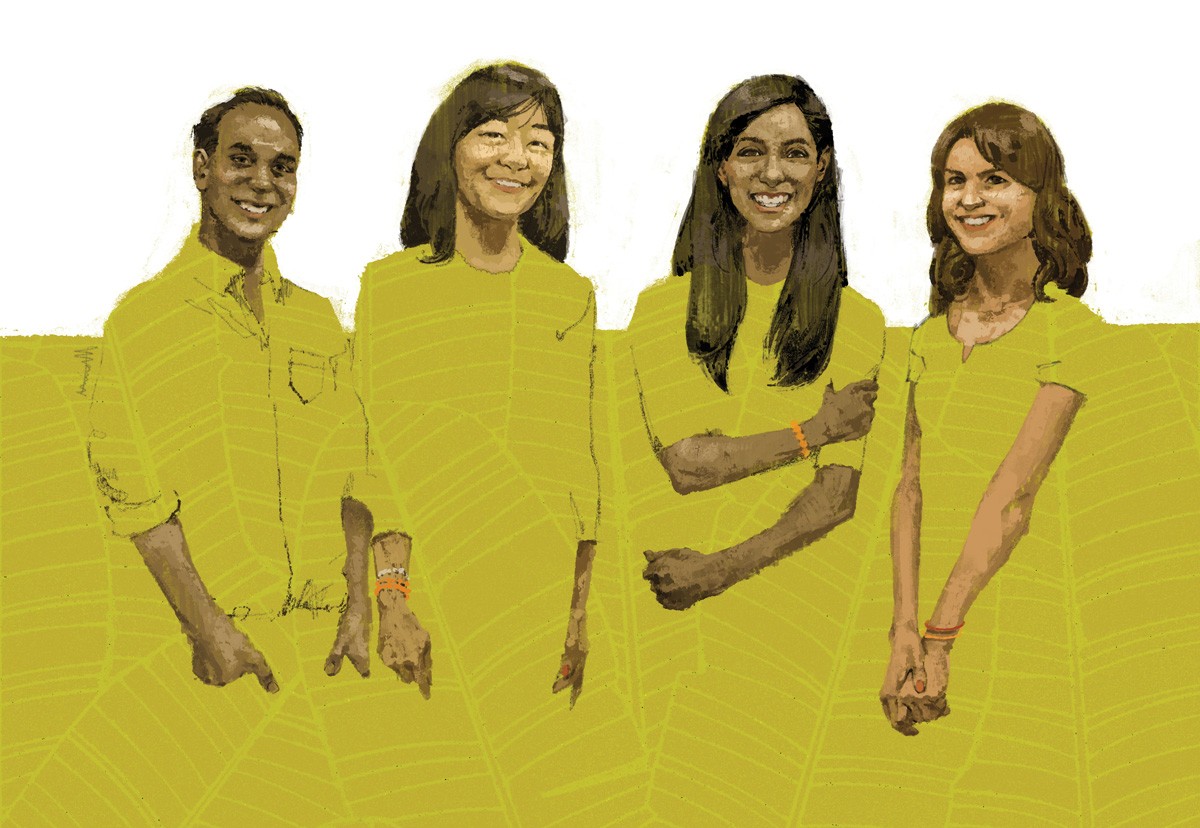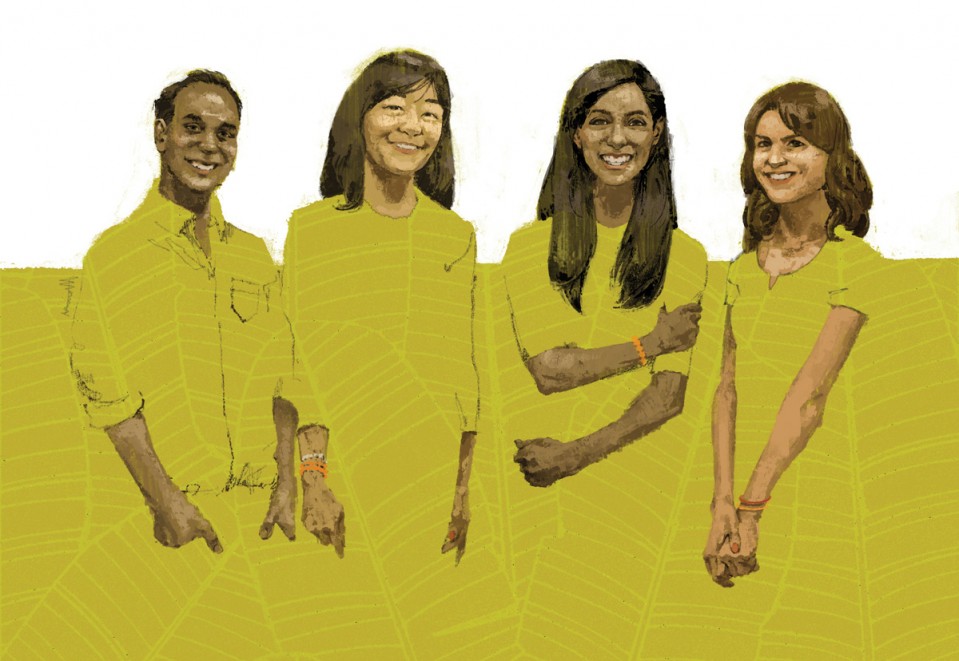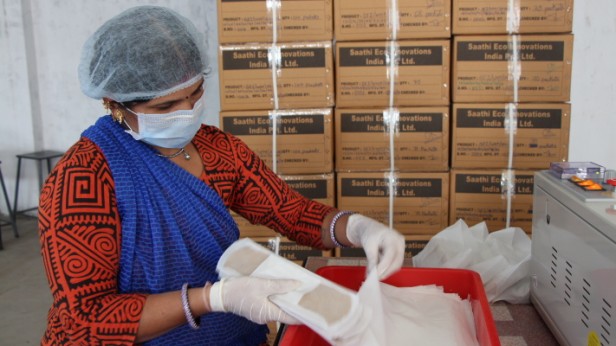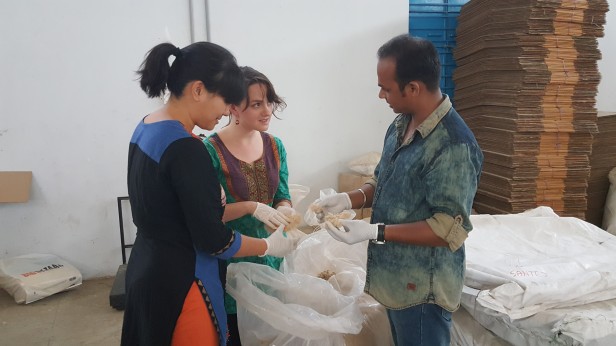

Rethinking Feminine Hygiene in India
A product idea hatched at MIT evolves into biodegradable menstrual pads—and a win for gender equity.

In the 1950s, Parvathy Ayyar, a young woman in what is now Thiruvananthapuram, India, spent one week every month sleeping in a hut outside her family’s home. During that time, she wasn’t allowed to attend school, go to religious services, or even use her family’s kitchen to cook. Nearly 70 years later, menstruation is still a social and economic hardship for women in rural India, many of whom lack access to adequate feminine hygiene products. But Ayyar’s granddaughter, Amrita Saigal, is working with two other MIT alumnae to keep it from restricting Indian girls’ and women’s lives.
In 2015, Saigal, Kristin Kagetsu, Grace Kane, and Tarun Bothra founded Saathi, a startup based in Ahmedabad, India, to produce affordable sanitary pads made from readily available, compostable materials. To make them accessible to all women, the company subsidizes the cost of pads sold in poor, rural regions by charging more for them in urban areas.
“In the U.S., we kind of think of our periods as such a pain and our tummies hurt and you have to go to CVS,” Saigal says. But in places like rural India, menstruation “can actually impact someone’s life,” she points out. “They’re missing school and then eventually dropping out.”
A study published in the journal BMJ Open found that one in four adolescent girls in India missed school during their periods. A 2010 study by AC Nielsen and the nongovernmental organization Plan India estimated that Indian girls miss an average of 50 days of school for this reason every year, and 23 percent drop out after hitting puberty. Although some critics dispute the figures, researchers agree that periods remain clouded in stigma in many parts of India. As a result, menstruating women in these areas—which are mostly rural—often still feel compelled to sleep separately from family, avoid physical contact with others, follow dietary restrictions, skip exercise, and miss religious services and social functions.
Existing methods of dealing with menstruation can cause medical as well as practical problems, as Saigal learned while doing design research on equipment used to manufacture sanitary pads during a summer internship at Procter & Gamble. Women in rural villages often rely on pieces of old cloth, but many don’t have fresh water and soap to clean them, and they’re often stored in dark places. All that encourages growth of microörganisms that can cause infections. Disposable pads are costly and not always available in rural areas; one study found that only about 5 percent of rural women used them.
In the fall of 2009, Saigal returned to MIT after her P&G internship and took Professor David Wallace’s 2.009 Product Engineering Processes class. In response to the theme of “emergency,” she and 15 classmates designed a low-cost machine that women in Rwanda could use to manufacture sanitary pads with local materials. After consulting with MIT chemical engineers, they decided to use banana-tree bark, one of the world’s most absorbent natural fibers. (It also happens to be readily available, since banana trees only produce a single crop of fruit and are cut down after each harvest.)
Seven team members kept working on the idea as their senior thesis project. Saigal, Katherine Smyth, and Zachary Rose continued after graduation and wrote a business plan aimed at selling the machines in rural India. The team won $5,000 in the 2010 MIT IDEAS Global Challenge and, having added D-Lab veteran Grace Kane and Joyce Fong, won $7,500 in Tufts University’s $100K Business Plan Competition the following year.
By 2011 other team members had left for grad school or jobs, but Saigal and Kane remained committed to the project. With support from the MIT Deshpande Center, Kane spent six months in Hubli, India; Saigal would conduct more market research in India before heading to Harvard Business School in 2012. Saigal knew that they needed a partner with experience developing products for poor areas. In 2013, Kagetsu, a former D-Lab classmate, joined the project. The following year, they won a $50,000 grand prize in the Harvard Business School New Venture Competition.
But just as the company was beginning to take off, the group hit a major hurdle. Kagetsu, who left her hardware engineering job at Oracle to move to India in late 2014, soon found that organizations making similar equipment were struggling to expand there. The teammates concluded that they couldn’t offer a machine significantly different from others on the market. But they saw another opportunity.
Most commercial pads sold worldwide are made with wood pulp, which requires cutting down trees, and superabsorbent polymers, which some estimate can take more than 500 years to decompose. In India alone, commercial pads currently create 43,000 tons of plastic waste annually. Because garbage in India is often thrown in the street, where it’s available to dogs and other animals, women frequently bury or burn their sanitary supplies, releasing toxins into the air and soil. So instead of building machines, the team decided to produce high-quality, biodegradable sanitary pads that could be composted or thrown into a biodigester to create electricity or fuel.
“We basically had to start again from scratch,” Kagetsu says. And this time the core team members were living on different continents.
Making the pads compostable would require finding a biodegradable material to replace the hydrophilic top layer and plastic bottom layer encasing the banana fiber. Producing a pad superior to those on the commercial market also meant figuring out how to process the long strands of banana fiber to maximize its absorbency. Partnering with Bothra, then a recent mechanical engineering graduate from nearby Nirma University, the group found a biodegradable plant-based material—a thermoplastic aliphatic polyester film often used in medical implants—that could substitute for the plastic bottom layer. The top layer, which allows liquid through, is also plant-based and fully biodegradeable. But determining how best to process the banana fiber proved trickier.
Users who tried the first Saathi pad prototypes at the end of 2015 said the product was functional but too bulky. With technical help from Kane, Kagetsu and Bothra contoured it to better fit a woman’s body, and after a year of engineering, testing, and tweaking, they developed a patent-pending processing technique to flatten and thin the fiber. After a third major iteration to optimize the pad for large-scale production, the Saathi team had developed a product that’s 50 percent more absorbent than commercial pads of the same size—and biodegrades completely in three to six months. Unlike most commercial pads, Saathi’s are not bleached or treated with chemicals like chloroform and styrene, which are suspected carcinogens; tests confirm that none of the materials in Saathi’s pads are carcinogenic. And because they’re made from locally sourced banana-tree fiber that would otherwise go to waste, Saathi is also generating a new revenue source for area banana farmers.
Kagetsu became an MIT D-Lab Scale-Ups Fellow in 2015, and Saathi pads went into production in 2016 at a zero-waste facility that reuses or recycles all manufacturing by-products. The company has since won numerous awards—including 3M-CII’s Young Innovators Challenge in the social category, the Asia Social Innovation Award, and a finalist spot at the 2017 South by Southwest Accelerator Pitch Event—and has worked to scale up production. Saathi currently employs 10 women in its production facility and plans to distribute one million pads by mid-2018.
“We know that when we distribute these pads in these villages, they’re not going to stick around in the soil for 500 years,” Kane says. “That’s a pretty cool impact.”


